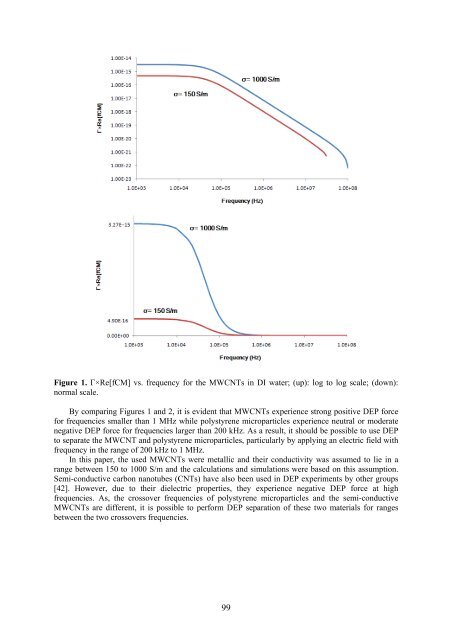Workshop proceeding - final.pdf - Faculty of Information and ...
Workshop proceeding - final.pdf - Faculty of Information and ...
Workshop proceeding - final.pdf - Faculty of Information and ...
Create successful ePaper yourself
Turn your PDF publications into a flip-book with our unique Google optimized e-Paper software.
Figure 1. Г×Re[fCM] vs. frequency for the MWCNTs in DI water; (up): log to log scale; (down):<br />
normal scale.<br />
By comparing Figures 1 <strong>and</strong> 2, it is evident that MWCNTs experience strong positive DEP force<br />
for frequencies smaller than 1 MHz while polystyrene microparticles experience neutral or moderate<br />
negative DEP force for frequencies larger than 200 kHz. As a result, it should be possible to use DEP<br />
to separate the MWCNT <strong>and</strong> polystyrene microparticles, particularly by applying an electric field with<br />
frequency in the range <strong>of</strong> 200 kHz to 1 MHz.<br />
In this paper, the used MWCNTs were metallic <strong>and</strong> their conductivity was assumed to lie in a<br />
range between 150 to 1000 S/m <strong>and</strong> the calculations <strong>and</strong> simulations were based on this assumption.<br />
Semi-conductive carbon nanotubes (CNTs) have also been used in DEP experiments by other groups<br />
[42]. However, due to their dielectric properties, they experience negative DEP force at high<br />
frequencies. As, the crossover frequencies <strong>of</strong> polystyrene microparticles <strong>and</strong> the semi-conductive<br />
MWCNTs are different, it is possible to perform DEP separation <strong>of</strong> these two materials for ranges<br />
between the two crossovers frequencies.<br />
99
















